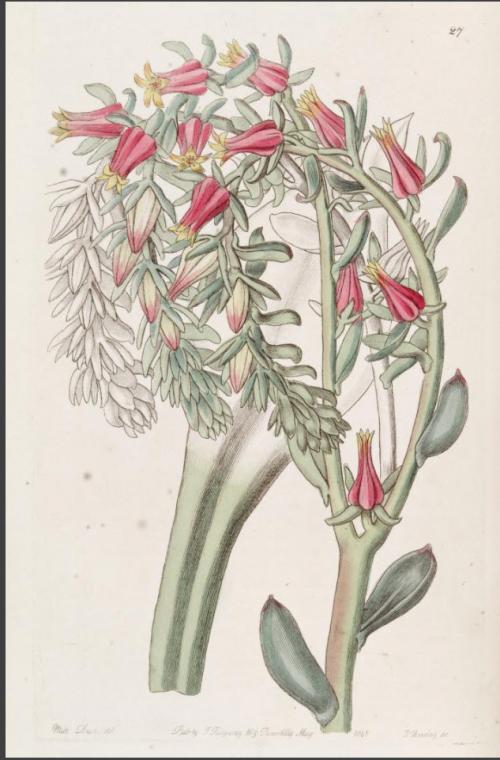SCHEERI Lindley, 1845
NO ORIGIN IN THE WILD. MOST LIKELY A HYBRID. LONG LOST TO CULTIVATION.
Synonym : Cotyledon scheeri (Lindley) Baker (1869)
Series Gibbiflorae
Type : Ex cult. Frederick Scheer.
Etymology : Named for Frederick Scheer who had furnished the seeds.
Distribution: No wild origin known.
First Description by Lindley in Edwards's Botanical Register 31 (New Ser.8): 27. 1845 :
Caulescens, foliis ovalibus acutis in petiolum planum elongatis, floribus racemoso- paniculatis, racemia nutantibus, sepalis linearibus acutia corolla brevioribus altero saepius majore.
A more detailed description by Baker as Cotyledon scheeri in Saunders, Refugium Botanicum 1: no.19. 1869 (compiled from Lindley's notes and figure) :
Caulescent, glabrous.
Leaves rosulate, oblongo-spathulate, the largest six to seven inches long by more than two inches broad three-quarters of the way up, the point acute, the lower two-thirds spathulately narrowed, both sides glaucous-green.
Leaves of the flowering branch numerous, but much reduced.
Flowers in a trifid raceme with secund drooping branches six to eight inches long, with ten to twelve flowers each.
Bracts half an inch to an inch long, the upper ones imbricated.
Pedicels erecto-patent, the lowest a quarter of an inch long.
Sepals linear, spreading, very unequal, a quarter to three-eighths of an inch long.
Corolla five-eighths to three-fourths of an inch long, red and yellow, decideley pentagonal.
Note :
1. Lindley wrote that for the introduction of this plant "the public is indebted to Frederick Scheer, Esq. of Kew, a zealous collector of succulent plants, and whose name it will henceforward bear. It is a native of Mexico, whence seeds were received by that gentleman and presented to the Horticultural Society in September, 1842." It is unknown exactly where from Mr Scheer got the seeds and the plant has never been found in the wild in Mexico. Very likely it was a hybrid. It is also unknown how long it was in cultivation in Europe.
2. When Walther wrote a description of E. scheeri, he made it from a "living plant grown in the Strybing Arboretum, Golden Gate Park, San Francisco, originally collected by Thomas MacDougall from the Chontal District, Mexico".
But : Such a plant is not mentioned at all in Tom MacDougall's published as well as unpublished fieldnotes; and also Charles Uhl who had examined three specimens from Walther did not think that they were correctly named.
Besides : A plant without known origin, in cultivation in the 1940s in California, cannot possibly be equated with a plant grown in a garden in London in the 1840s, almost a century ago.
Whatever plant Walther described - in any case it had nothing to do with E. scheeri Lindley - and his use of the name E. scheeri is incorrect. Accordingly his description is unusable and therefore also Kimnach's summary in the Illustrated Handbook of Succulent Plants, 2003, based on Walther.
3. When Charles Uhl (Haseltonia 9, 2002) commented on E. scheeri as being most likely a hybrid with the same parents as E. juarezensis he was referring to Walther's plant of unknown origin (the identity of which he doubted) and again not to Lindley's E. scheeri. Therefore his estimation is of no value regarding the true E. scheeri.
4. Pilbeam published a photo by R. Moran, taken in 1949 (The genus Echeveria p. 244, fig. 339, 2008) and mentioned that it is a match for the original publication - in view of the protologue illustration (see below) this is nonsense.
5. All photos / paintings concerning E. scheeri published in the 20th century do not correspond to the original E. scheeri. They are of no use and are to be ignored.

Echeveria scheeri.
Protologue illustration of the type plant, from Edwards's Botanical Register 31 (New Ser.8): t.27. 1845.